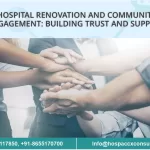By Hospaccx Healthcare Business Consulting
Hospital renovations are a complex process that often involve significant structural changes. While many focus on expanding medical facilities or upgrading technology, one critical, yet often overlooked, aspect is the integration of wayfinding systems. Wayfinding refers to the strategies and design elements that guide people through a physical environment. In hospitals, where the layout can be intricate and overwhelming, a well-thought-out wayfinding system can significantly enhance patient care, improve safety, and reduce anxiety.
In this blog, we’ll explore the vital role of wayfinding in hospital renovation projects and how it can elevate the healthcare experience for both patients and staff.
What is Wayfinding in Healthcare Design?
Wayfinding is the process of using signage, maps, spatial arrangements, and visual cues to help people navigate complex environments. In healthcare settings, this includes clear and intuitive directional signage, floor plans, color schemes, and architectural design elements that guide visitors, patients, and staff.
The importance of effective wayfinding in hospitals cannot be overstated. The hospital environment can be daunting and stressful, especially for patients and families who may already be dealing with anxiety. Wayfinding reduces confusion, helping individuals reach their destinations quickly and efficiently while minimizing stress.
Why is Wayfinding Crucial in Hospital Renovation?
Hospital renovations often lead to shifts in departments, the addition of new services, and changes in building structure. These changes can cause confusion if not accompanied by a clear wayfinding strategy. Without it, hospitals risk delays in patient care, increased anxiety, and staff inefficiency.
Effective wayfinding in hospital renovations provides numerous benefits:
- Improved Patient Flow: Clear signage helps patients reach their appointments or departments with ease, reducing waiting times.
- Enhanced Patient Experience: Reduced stress for patients and visitors contributes to a more positive overall experience.
- Increased Staff Efficiency: Well-planned pathways allow staff to move efficiently between departments.
- Safety Promotion: Clear markings ensure patients and staff can easily identify emergency exits, critical care areas, and safety zones.
Key Elements of Hospital Wayfinding Design
When designing wayfinding systems during hospital renovations, several key elements should be considered to ensure the system is intuitive and effective. Here are some critical components:
Clear and Consistent Signage
Signage forms the foundation of any wayfinding system. It must be easy to read, placed at key decision points (such as intersections and entrances), and simple to understand.
- Design Tips:
- Use large fonts and avoid medical jargon.
- Incorporate color coding to differentiate various hospital zones (e.g., blue for outpatient areas, green for intensive care).
- Provide multilingual signage to accommodate diverse patient populations.
- Benefits: Clear, consistent signage reduces confusion and enables quick identification of key areas.
Digital Wayfinding and Interactive Kiosks
Incorporating technology enhances wayfinding by providing real-time information and interactive features.
- Design Tips:
- Install digital kiosks at major entrances and high-traffic areas for immediate assistance.
- Consider mobile apps or QR codes to guide patients based on their current location.
- Benefits: Interactive kiosks and apps provide up-to-date directions and reduce dependency on hospital staff for guidance.
Visual Cues and Landmarks
Color schemes, shapes, and unique architectural features can serve as landmarks, making navigation more intuitive.
- Design Tips:
- Color-code walls or flooring to guide people to specific departments.
- Use art installations or distinctive architectural features as visual landmarks.
- Benefits: Visual cues help people orient themselves without the need for excessive signage, easing cognitive load.
Spatial Layout and Building Organization
An organized, logical layout can make navigation far more intuitive, reducing confusion and ensuring people move easily through the hospital.
- Design Tips:
- Group related services together (e.g., outpatient care in one section).
- Use wide, open hallways to minimize the risk of confusing or cramped spaces.
- Avoid unnecessary detours and create clear, direct pathways between critical departments.
- Benefits: A well-organized layout ensures both patients and staff can navigate the hospital quickly and efficiently.
Intuitive Parking and Entry Points
For many visitors, navigating the hospital begins before even entering the building—finding parking and the most convenient entrance is essential.
- Design Tips:
- Use large, clear signs to direct visitors to parking areas and entrances.
- Provide valet services or designated spaces for patients with disabilities.
- Benefits: Clear parking and entry signage reduces stress for visitors, creating a smoother arrival experience.
The Role of Wayfinding in Patient Experience and Safety
The physical environment of a hospital significantly impacts the overall patient experience. A confusing or frustrating navigation experience can create unnecessary stress, potentially delaying care or complicating safety.
Wayfinding’s Impact on Patient Care:
- Reduced Anxiety: Patients who can easily navigate the hospital are likely to experience less stress, which can positively impact their overall well-being.
- Improved Timeliness: Clear directions help patients arrive on time for appointments or treatments, contributing to operational efficiency.
Enhanced Safety: A clear wayfinding system ensures individuals can easily locate emergency exits, critical care units, and other safety features.
Incorporating Family and Visitor Needs in Wayfinding
Visitors and family members often play an essential role in patient recovery, but they may be unfamiliar with the hospital layout. Designing a wayfinding system that meets their needs is just as important.
Design Tips for Visitors and Family Members:
- Provide directions to visitor lounges, cafeterias, and family support areas.
- Consider integrating apps that allow visitors to track patients’ locations or receive updates.
- Designate family-friendly spaces for comfort and privacy during long visits.
Benefits: A wayfinding system that caters to visitors ensures they feel at ease, contributing to a better overall experience.
Continuous Improvement and Feedback
Wayfinding systems must evolve as hospitals grow and services change. Gathering feedback from patients, visitors, and staff after renovations helps identify areas for improvement.
- Design Tip: Regularly assess the wayfinding system, gather feedback, and make necessary adjustments.
- Benefits: Continuous improvements keep the wayfinding system aligned with evolving hospital needs and ensure optimal navigation experiences.
Conclusion: Navigating the Future of Hospital Renovation
Wayfinding is an essential element of hospital renovations that enhances operational efficiency, patient safety, and the overall experience. Thoughtful design of wayfinding systems helps create a healing environment where both patients and visitors feel confident and supported. In today’s fast-evolving healthcare environment, incorporating clear, intuitive navigation systems is one of the most effective ways to improve hospital functionality and ensure positive outcomes.
Hospaccx Healthcare Business Consulting specializes in strategic consulting for hospital renovations and expansions. Our experts work alongside healthcare providers to create patient-centric, efficient environments that enhance care delivery and operational effectiveness.
For expert consultation on hospital renovation and wayfinding design, visit Hospaccx Healthcare Business Consulting. Subscribe to our blog for more insights on hospital design and renovation strategies.
RelevantHashtags:
#HospitalRenovation #HealthcareDesign #Wayfinding #PatientExperience #HospitalEfficiency #HealthTech #HospitalExpansion #HealthcareConsulting #DesignThinking #HospitalLayout #PatientSafety #MedicalDesign #WayfindingSystems
Related Team Members




















